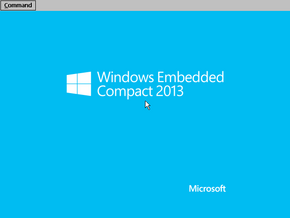Windows Embedded Compact
 | |
| Developer | Microsoft Corporation |
|---|---|
| Source model | Closed-source |
| Initial release | Windows CE 1.0 (16 November 1996) |
| Latest release | Windows Embedded Compact 2013 (13 June 2013) |
| Supported platforms | x86, ARMv7 |
| Kernel type | Hybrid |
| License | Proprietary |
Windows Embedded Compact (formerly Windows CE, where CE stands for Compact Edition or Consumer Electronics) was a real-time embedded operating system by Microsoft. Part of the Windows Embedded platform, Windows CE was designed for use with handheld computers or systems with limited memory and resources.
The system kernel and libraries were used in Windows Mobile and its successor Windows Phone, which were designed for smartphones and pocket PCs, as well as a runtime library for the Sega Dreamcast video game console. The Windows CE architecture was dropped with the release of Windows Phone 8, opting to use the NT kernel as part of the MinWin architecture.
History[edit | edit source]
Early versions of Windows CE were inspired by the Microsoft WinPad operating system, a scrapped mobile platform for handheld PCs based on the 16-bit Windows family. Versions of WinPad can be found in various Windows 3.1 SDKs. It is also included in early development builds of Windows 95 up till build 275.
Timeline[edit | edit source]
| Name | Version | Code name | Release date | Support end date | Notes |
|---|---|---|---|---|---|
| Windows CE 1.0 | 1.0 | Pegasus, Alder | 1996-11-16 | 2001-12-31 | First release of Windows CE; released for H/PC (Handheld PC) devices only |
| Windows CE 2.0 | 2.0 | Jupiter, Birch | 1997-09-29 | 2005-09-30 | Added support for many device architectures and standard APIs |
| Windows CE 3.0 | 3.0 | Cedar, Galileo | 2000-06-15 | 2007-10-09 | |
| Windows CE 4.0 | 4.0 | Talisker | 2002-01-07 | 2012-07-10 | |
| Windows CE 4.1 | 4.1 | Jameson | 2002-07-30 | 2013-01-08 | |
| Windows CE 4.2 | 4.2 | McKendric | 2003-04-23 | 2013-07-09 | |
| Windows CE 5.0 | 5.0 | Macallan | 2004-07-09 | 2014-10-14 | |
| Windows CE 6.0 | 6.0 | Yamazaki | 2006-11-01 | 2018-06-10 | Last version to be called "Windows CE" |
| Windows Embedded Compact 7 | 7.0 | Chelan | 2011-03-01 | 2021-04-13 | |
| Windows Embedded Compact 2013 | 8.0 | — | 2013-06-13 | 2023-10-10 | Last version to be released |
